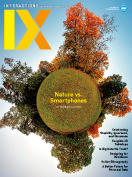Authors:
Tao Dong, Mark Newman, Mark Ackerman
In the past few years, we have seen a wave of new "smart" consumer products that make everyday places aware of our activities. There are thermostats that adjust temperatures based on occupancy [1], doors that alert us when we forget to close them, and "beacons" that track our indoor locations [2]. With recent advances in sensor technologies and the Internet of Things, every corner of our world is slated to gain some capability of capturing our activity traces. As everyday places become more aware of what we do, an enormous volume of activity traces can be captured and potentially…
You must be a member of SIGCHI, a subscriber to ACM's Digital Library, or an interactions subscriber to read the full text of this article.
GET ACCESS
Join ACM SIGCHIIn addition to all of the professional benefits of being a SIGCHI member, members get full access to interactions online content and receive the print version of the magazine bimonthly.
Subscribe to the ACM Digital Library
Get access to all interactions content online and the entire archive of ACM publications dating back to 1954. (Please check with your institution to see if it already has a subscription.)
Subscribe to interactions
Get full access to interactions online content and receive the print version of the magazine bimonthly.






